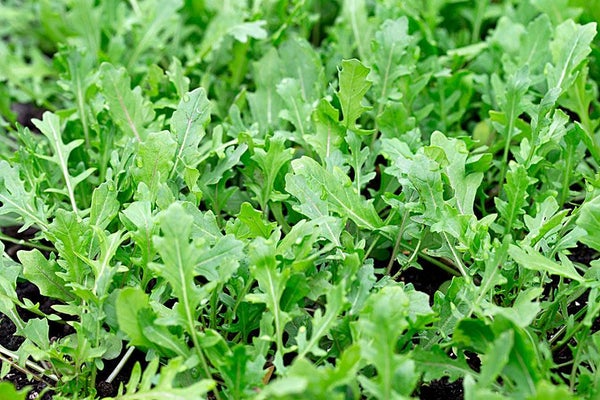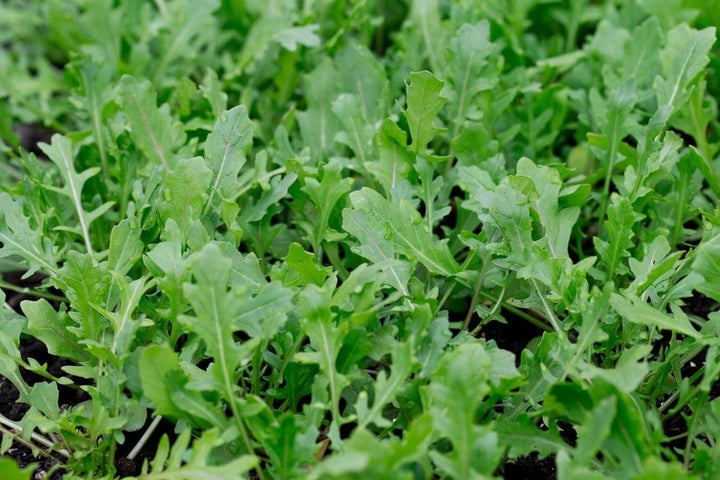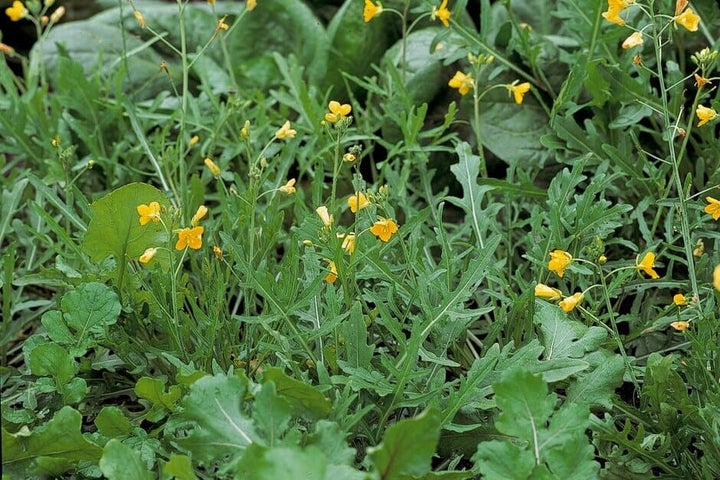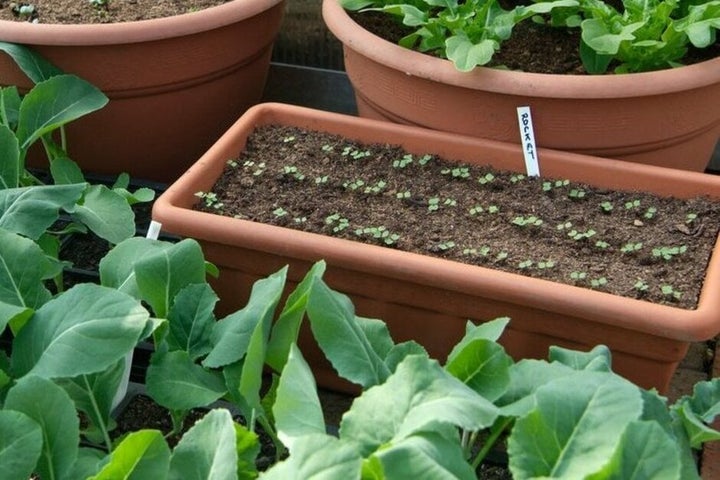
Getting Started
Spicy, peppery rocket leaves are a popular addition to salads and easy to grow from seed, for harvesting in as little as a month. Rocket thrives in sun or light shade, in containers and in the ground.

Rocket, also known as arugula or roquette, is a member of the mustard family, and there are two main types to grow – wild rocket and salad rocket. Both form compact, leafy plants that are great in small spaces and containers. Wild rocket produces harvests over a long period, while salad rocket is shorter lived, so is best sown little and often.
Young rocket leaves are milder, more tender and delicately flavoured, and should be picked regularly to keep plants producing more. The older leaves can also be used, lightly cooked or stir-fried. The flowers are edible too, also having a peppery kick. Rocket grows in a similar way to many other leafy salad crops, so it’s worth growing several different types together, to enjoy in mixed salads. See our growing guides below.
Jobs to do now
Harvest
Month by Month
Sow
Harvest
Choosing What To Grow

Rocket is very easy to grow from seed. There are two different types to choose from:
- Wild rocket (Diplotaxis tenuifolia) is a plant, living for several years. Robust and easy to grow, even in poor soil, it produces long, deeply divided leaves with a strong peppery flavour. It is slower growing and crops over an extended period, even in winter if protected under cloches or in a greenhouse
- Salad rocket or garden rocket (Erucavesicaria subsp. sativa) is an annual, with a productive lifespan of only a few months. Its leaves are more delicate, larger and usually less divided, and milder tasting. It flowers readily in hot weather, putting an end to harvests, so regular sowing is essential to replace spent plants. In cooler weather, plants will crop for longer. There are several varieties to choose from, with different leaf shapes and flavours
What and where to buy
Rocket seeds are readily available in garden centres and from online seed retailers. Wild rocket may also be available as young plants in garden centres, often in the herbs section. Some garden centres may also sell of salad rocket in spring and early summer.
Recommended Varieties


‘Sky Rocket’
Salad rocket – upright, serrated leaves offer wild rocket’s flavour but with faster growth.
Preparing The Ground
Rocket likes fertile soil that retains some moisture, although wild rocket will also grow well in poorer, drier soil. A sunny site is ideal for spring and late summer sowings, but for early/mid-summer sowings of salad rocket, it’s better to choose a cooler spot in light shade, to prolong cropping.
Prepare your growing site in advance by weeding the ground then raking it to remove any large stones and level the surface. If your soil is light and free-draining, fork in some garden compost to help retain moisture. Alternatively, if you're practising no-dig, the soil ahead of sowing or planting directly into the mulch.
Sowing

You can sow rocket seeds indoors or outdoors, in the ground or in containers, from spring through to late summer, or even later with protection. The plants take up very little space, so are perfect for small gardens and for pots on patios, balconies and doorsteps. With shorter-lived salad rocket, sow small batches every few weeks, to provide continuous harvests all summer long. Once one batch is finished, the next one will be ready to start harvesting. If you allow some plants to flower and produce seeds, they’ll self-seed to give you new plants without any effort.
Sowing indoors
Sowing rocket indoors allows you to get plants off to a reliable start, especially when conditions are unsuitable outside. The will also be safe from slugs and snails. For earlier harvests, sow rocket in February and March, and for harvests into winter sow in August and September and keep the plants in a greenhouse or other protected location.
Sow the seeds thinly in small pots or modular trays filled with moist, peat-free . Place in a warm, bright location such as on a windowsill or in a . You can also sow into larger pots, at least 30cm (12in) wide, as their final growing location.
Seedlings should appear in only a few days. Once they have at least a few leaves and are robust enough to handle, move them into individual /pots if necessary – see our video guide to pricking out. When the young plants are about 10cm (4in) tall, you can move them outdoors, from spring to late summer, into containers or the ground – see Planting, below.
You can also sow rocket seeds in a greenhouse border in late summer, for harvesting over winter. Sow in shallow drills and thin out the seedlings to a final spacing of 15cm (6in) apart.
Sowing outdoors
Sow rocket outdoors from April to early September, and for a further month under cloches or plastic-free fleece. Prepare the ground as above, then make a short, shallow up to 1cm (½in) deep, water along the base and scatter the seeds thinly along its length. Cover lightly with soil then firm gently. Allow 15cm (6in) between rows.
should appear in just a few days. Once they’re large enough to handle, thin them out to 15cm (6in) apart and use the thinnings in salads. Overcrowded plants tend to flower (or bolt) more rapidly. Protect young plants from slugs and snails.
Sowing in a container
Most types of container are suitable for growing rocket, including patio pots, windowboxes, hanging baskets and growing bags. Larger containers are preferable – at least 30cm (1ft) wide – as the will dry out less quickly. Fill your container with peat-free, multi-purpose compost, then scatter the rocket seeds thinly over the surface. Cover lightly with fine compost, firm gently and water well. For more container-growing tips, see our easy sowing guides below.
Planting

Young rocket plants grown from seed indoors or recently bought can be planted outside when they’re about 10cm (4in) tall, from April to early September. Prepare the plants for outdoor conditions by hardening off, so they don’t suffer a check in growth. Then plant into prepared soil in a warm, sunny spot. Space rocket plants 15cm (6in) apart and water in well. In autumn, you can also plant rocket in a greenhouse border to crop over winter.
Rocket grows well in large containers too – use a pot at least 30cm (1ft) wide or a large windowbox or trough. Fill it with peat-free, multi-purpose and space the plants 15cm (6in) apart.
In hot weather, young transplants can quickly wilt, so plant them in a cooler, lightly shaded location, which should also deter bolting (premature flowering), and water regularly.
Plant Care
Rocket needs little maintenance, apart from ongoing protection from slugs and snails, and regular watering to prevent drying out. When growing rocket in containers over summer, move them into a shadier spot during hot spells, to delay flowering.
Watering
Keep the soil moist, watering in dry spells, to ensure consistent growth and prevent plants running to seed (bolting) prematurely. When growing rocket in containers, water regularly in warm weather, as the will dry out quickly. Regularly weeding around rocket plants helps reduce competition for water.
Flowering
Salad rocket is an annual, so after floweringand seeding, the plants will die. Pinching out the developing flower stems will prolong cropping slightly, but it’s only a temporary fix. Plants flower sooner in hot, dry weather, so keep them well watered and avoid planting in full sun in the height of summer.
Wild rocket, on the other hand, is a and will continue producing edible leaves after flowering, for the rest of the and potentially for several years to come. Trim plants back if they get too large and sprawling, to encourage fresh new leaves.
Rocket flowers have a peppery flavour and can be added to salads.
Harvesting

Rocket can provide pickings from early summer through to autumn, and with protection, into winter too. You can usually start harvesting leaves about four to six weeks after sowing. Regular picking keeps growth young, tender and tasty. Older leaves can be lightly cooked as a spinach substitute or added to stir-fries and sauces.
Pick rocket as a cut-and-come-again crop, taking a few leaves from each plant along the row. If you take lots of leaves from just one plant, it will be slow to recover. The white, four-petalled flowers are edible too and can be added to salads.
The two types of rocket crop in different ways:
- Salad rocket will provide fresh leaves for a month or two, depending on temperature and time of year. You should be able to take several harvests from a row, before the plants start to flower. Once they flower (or bolt), their leafy harvest is over and plants should be removed. Repeat sowing is vital for a long harvesting season. Salad rocket leaves are generally milder in flavour and more tender
- Wild rocket produces hot, spicy leaves for a long period, right through summer and autumn, and if protected under cloches or in a coldframe or greenhouse, it may keep cropping into winter, then start again in early spring. Plants will continue producing leaves after flowering, unlike annual salad rocket. The flavour tends to get hotter in summer
Problem Solving
Protect and young plants from slugs and snails. Rocket leaves may also be nibbled by flea beetles, but this is just cosmetic damage. Annual salad rocket tends to quickly in hot weather, which spells the end of the crop, so it’s best grown in light shade in summer and sown regularly in small batches. For more on how to tackle these issues, see Common problems below.
Common Problems

Bolting in vegetables
Bolting is the term applied to vegetable crops when they prematurely run to seed, usually making them unusable. A cold spell or changes in day length...

Flea beetles on brassicas and allied plants
Some species of flea beetle feed on the leaves of all brassicas and related plants, including rocket, radish, swede, turnip and wallflowers. The resul...

Slugs and snails
Slugs and snails are common garden animals, and they are well suited to the damp, mild climate of the UK. A few species feed on garden plants, but mos...



